Unit 1
Introduction to Graphics Devices
The display device is an output device which is used to represent the information in the form of images.
It is also known as the video monitor or video display unit (VDU).
This devices are designed to display, view, model or display information.
The main advantage of displaying is the sharing of information.
There are some display devices given below.
Cathode ray tube (CRT)
It is a traditional computer monitor and television.
It a particular type of vacuum tube that displays images when an electron beam collides on the radiant surface.
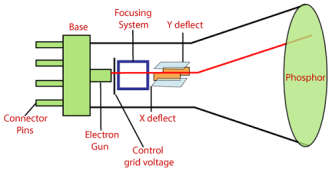
Following are the elements of the CRT.
Electron gun: it is focused on narrow beam facing the CRT
Focusing and accelerating anodes: Used to produce a narrow and sharply focused beam of electrons.
Horizontal and vertical deflection plates: used to guide the path of the electron beam which produces the electromagnetic field that bends the electron beam through the area as it travels.
Phosphorus coated screen: used to produce bright spots when the high velocity electron beam hits it
Color CRT Monitor
It is same as CRT monitor.
It is basically used to combine three colors that is red, green and blue.
By using this three colors we can create millions on different colors.
There are two basic color display producing techniques are given below:
a) Beam Penetration Method:
It is used with a random scan monitor for displaying picture.
In this there are two phosphorus layers that are red and green which are coated inside the screen.
The colors are depends on how far the electron beam penetrates the phosphorus surface.
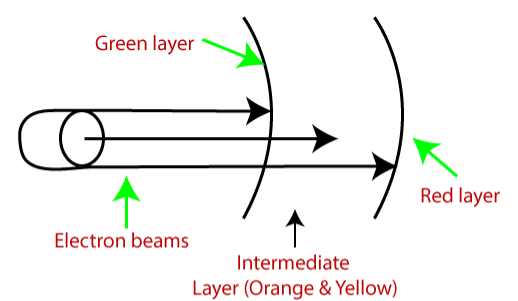
b) Shadow Mask Method:
It is used with raster scan monitor for displaying pictures.
It has more range of color than beam penetration method.
It is used in television sets and monitor.
It has three phosphorus color dots at each position of the pixel.
First for red color, second for green and third for blue color.
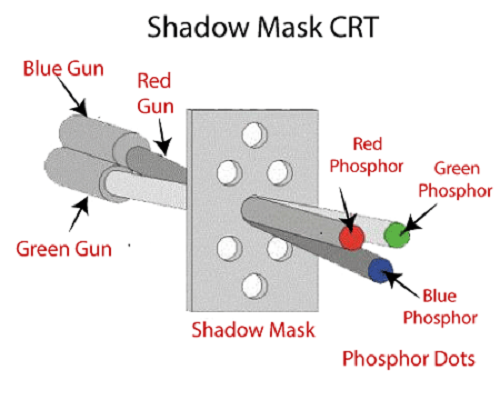
Light Emitting Diode (LED)
It is a semiconductor device.
It emits when current passes through it.
It has small size hence we can make any display unit by arranging a large number of LEDs.
It consumes more power than LCD.
It is used in TV, smartphones, motor vehicles, traffic light, etc.
It has power to stand with mechanical pressure as it is powerful.
It also works at high temperature.
Direct View Storage Tube (DVST)
It is used to store the picture information as charge distribution behind the phosphorus coated screen.
It has two guns:
Primary gun: used to store the picture information
Flood or secondary gun: used to display a picture on the screen.

Plasma Display
It is also called as gas discharge display.
It is type of flat panel display which uses tiny plasma cells.
It has following components:
Anode: used to deliver a positive voltage.
Cathode: used to provide negative voltage to gas cell
Gas plates: works as capacitor. As soon as the voltage passes, the cell lights regularly.
Fluorescent cell: As soon as the voltage passes to the neon gas it emits light.
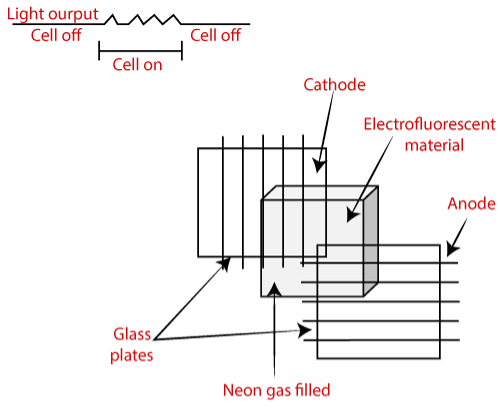
3D Display
It is also called as stereoscope display technology.
It has capability to bring depth perception to the viewer.
It is used in 3D gaming and 3D TVs.
Some examples of 3D display are such as holographic display, retina display, fog display, etc.
The printers are divided into two main parts as inkjet and laser printer.
The working of the printer is quite simple.
The printer is the machine which converts the digital images or text into physical copies.
The functioning of printer depends on driver or specialized software that converts the file into a language that printer can understand.
The image or text will be recreated on to the page using series of dots or pixels.
As the method differs with the transferred of dots onto the page in various machines.
Inkjet Printer:
Following figure shows the working principle of inkjet printer.
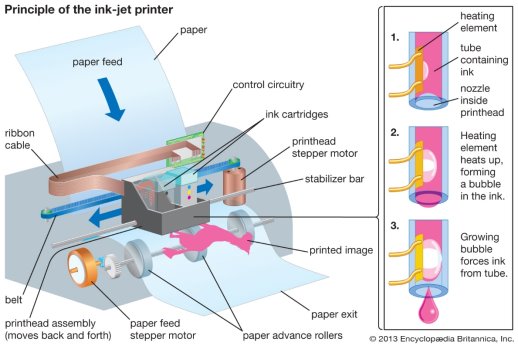
In the inkjet printer there are thousands of holes on printer head.
The printer prints on the paper by this tiny holes as it opens the microscopic droplets of the ink at the speed.
This machine uses the liquid ink to print.
The liquid ink as it can be either colouerd dye or liquid which contains solid pigments.
The paper and the ink passes from the printer head are perpendicular to each other where the printer head moves horizontally in the machine.
As the printer head moves on the page the individual hole of its activated and small drop of ink is pushed on the page.
If the process is performed at high speed with thousands of droplet that forms together to recreate the digital image or text that is being transferred on the media.
As the dots are too tiny the image or text printed on the page become a solid image.
Laser/LED Printer:
Following figure shows the working model of laser printer.
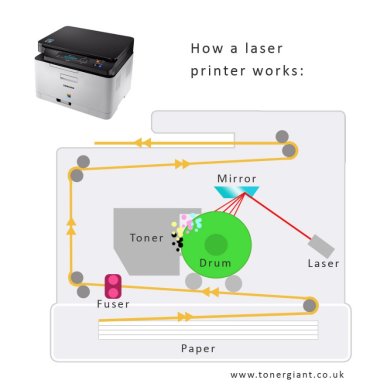
The working of laser printer is complex that the inkjet printer.
Laser and LED printer works similar as inkjet printer.
In inkjet printer there are too many tiny dots which uses the liquid ink to print that forms the solid image on the page.
In laser or LED printer the dots are different where the laser uses dots made up of toner i.e. fine powder of solid particles to recreate the image on page.
The laser printer uses power supply, photosensitive drum, toner cartridges, corona wires, fuser unit, waste toner bottle.
The process of printing in laser machine has many stages as compared to inkjet.
It uses a heated wire to positively charge a drum then it passed over by the laser that reverse the charge in the areas that in hits.
Hence the negatively charged areas of the drum represents the image or text that is to be printed.
The toner that used for printing passed over the drum and stick to the negatively charged areas.
The paper is fed underneath the toner coated drum and the toner is passed on its surface which creates printer copy of digital document or image.
It offers the superior printing experience at a lower overall price that inkjet printers.
It is an electronically modulated optical device which is uses the light modulating properties of liquid crystals that combines with polarizers.
It looks as flat panel device.
Liquid crystals does not uses the emitting light directly but instead of emitting light it uses the backlight or reflector to show image in color.
It is depends on the light modulating properties of liquid crystal.
It requires the AC power than DC hence it is difficult to use in circuit.
It uses watches and portable computers.
It consumes less power than LED and also it works on flat panel display technology.
It uses the liquid crystal to turn on or off the pixels.
Following figure shows the reflective twisted liquid crystal display.

In above figure step 1 is of polarizing filter which polarized light as it enters.
Step 2 is of glass substrate with ITO electrodes that shows the shapes on the screen when LCD is on.
Step 3 contains the twisted nematic liquid crystal.
Step 4 contains the glass substrate with common electrode ITO with horizontal lines up with horizontal filters.
Step 5 consist of polarizing filter film to block light horizontally.
Step 6 shows the reflective surface to send light back to the screen.